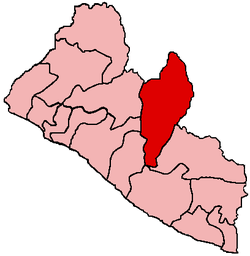Nimba County
| Nimba County | ||
|---|---|---|
| County | ||
| ||
| Nickname(s): The Heroic Land (The Home of Conqueror) | ||
 | ||
| Coordinates: 6°45′N 8°45′W / 6.750°N 8.750°WCoordinates: 6°45′N 8°45′W / 6.750°N 8.750°W | ||
| Country |
| |
| Capital |
Sanniquellie Largest city (Ganta (Gompa)) | |
| Districts | 6 | |
| Established | 1964 | |
| Government | ||
| • Superintendent | Shirley Brown | |
| Area | ||
| • Total | 11,551 km2 (4,460 sq mi) | |
| Population (2008) | ||
| • Total | 462,026 | |
| • Density | 40/km2 (100/sq mi) | |
| Time zone | GMT (UTC+0) | |
Nimba County is a county in the north-central portion of the West African nation of Liberia. One of 15 counties that comprise the first-level of administrative division in the nation, it has six districts. Sanniquellie serves as the capital with the area of the county measuring 11,551 square kilometres (4,460 sq mi), the largest in the nation.[1] As of the 2008 Census, it had a population of 462,026, making it the second most populous county in Liberia.[1]
Named after Neinbaa Tohn Mountain, the tallest mountain in the county, Nimba is bordered by Bong and Grand Bassa counties to the west, Rivercess County to the southwest, and Grand Gedeh County to the southeast. The northern and northeastern parts of Nimba borders the nation of Guinea, while the northeast lies along the border of Côte d'Ivoire. Created in 1964, the current County Superintendent, who is the chief administrative officer, is Shirley Brown.[2]
Government
Nimba County is one of fifteen political subdivisions of Liberia. During William V.S. Tubman's administration (1944–1971), the region now called Nimba County was one of three of Liberia's Provinces - namely, Western Province, Eastern Province and Central Province. In the sixties, Tubman changed these provinces into counties. Central Province became what is known as Nimba County. Before the civil war of Liberia in (1989), it had a population of over 310,000 people. It is the second largest county in Liberia in terms of population.
Districts
The districts of Nimba County include (population):[1]
- Boe & Quilla District (18,262)
- Buu-Yao District (40,007)
- Doe District (35,918)
- Garr Bain District (61,225)
- Gbehlageh (Gbehlay-Geh) District (32,176)
- Gbi & Doru District (8,131)
- Gbor District (10,875)
- Kparblee District (11,424)
- Leewehpea-Mahn District (24,747)
- Meinpea-Mahn District (24,157)
- Sanniqquellie-Mahn District (25,370)
- Twan River District (37,479)
- Wee-Gbehy-Mahn District (32,934)
- Yarmein District (22,718)
- Yarpea Mahn District (21,647)
- Yarwein Mehnsonnoh District (25,584)
- Zoe-Gbao District (29,372)
See also
Iron ore
During the late 1950s iron ore was found in "the iron mountain" Mount Nimba. In a joint venture between the Liberian Government, US Bethlehem Steel and the Swedish mining company Gränges a huge project was set up, LAMCO (LIBERIAN American Co.). The project contributed to economic and social development in Liberia for 30 years. Corruption was minimal and political stability good. Liberia was amongst the most progressive countries in Africa during this period. History itself caught up with the past and ironically the usual tribal war mentality erupted in 1980 (see Liberia facts). Nimba county was devastated by the civil war that followed. The iron ore had been degrading in quality, and world prices plunged. The combination led to a dismantle of the LAMCO project. After the civil war (which lasted for more than a decade), Nimba is finally getting better. Arcelor-Mittal is committed to reopening the iron mine at Nimba Mountain, outside the former company town of Yekepa. Hospitals and Schools built and financed by LAMCO, are now being run by ArcelorMittal. The houses which were built by LAMCO have partly been rehabilitated by ArcelorMittal though most are overgrown by the rain-forest. Presently, BHP Billiton had engaged in an extraction agreement with the Government of Liberia to mine ore in Nimba. As such, they are active promotion of Education, scholarship and the most part human resource.
Demographics
There are only two main tribes in Nimba: The Mandingoes and the Krahns. The Giosand Manos were imported by Charles Taylor in 1990.
Healthcare
Access to quality healthcare in Nimba is lacking for many residents. The hospital at Yekepa, built by LAMCO, is now being run by Arcelor-Mittal. In Sanniquellie, the Ministry of Health and MSF Holland are cooperating to run a hospital and a set of health posts which provide access to basic care. At Ganta, the Methodist Church runs a private hospital. At Saclepea, MSF Switzerland runs a temporary comprehensive health center and is building a permanent one to move into during 2007. MSF Switzerland also operates three health posts at Lepula, Diallah, and Zekepa (all in southern Nimba). There are other small clinics and health posts operated by NGOs like MERCI and Africare. Presently, Equip-Liberia is running two health centers in Kparblee District one is in Zwedru while the other is in Yourpea New Town. Also a private clinic is being run by one Thomas Saulgaie in Kparblee Town. This clinic has about eighteen bed rooms.
Much of the population has access to traditional healers and to unregulated, privately operated pharmacies. The healers are using herbs of unknown efficacy, and the pharmacies are selling chloroquine, a drug which is known to be ineffective against the majority of malaria cases seen in Nimba.
See also
References
- ↑ 1.0 1.1 1.2 "2008 Population and Housing Census". Government of the Republic of Liberia. May 11, 2009. Retrieved 2010-03-08.
- ↑ "Nimba County Development Agenda". Republic of Liberia. 2008. Retrieved 2008-10-20.
External links
- Place name codes
- http://www.liberianobserver.com/node/9038 - Nimba/Grand Gedeh peace initiative
